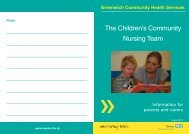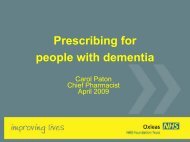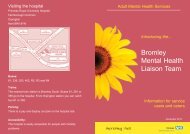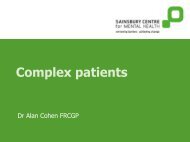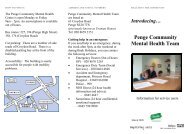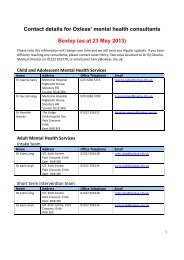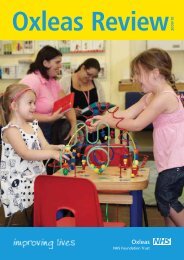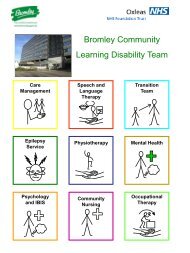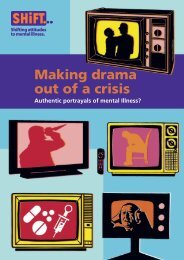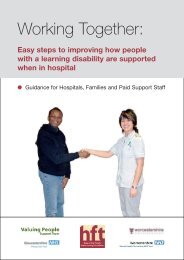Early Intervention for young people with psychosis - Gemma Allison ...
Early Intervention for young people with psychosis - Gemma Allison ...
Early Intervention for young people with psychosis - Gemma Allison ...
You also want an ePaper? Increase the reach of your titles
YUMPU automatically turns print PDFs into web optimized ePapers that Google loves.
<strong>Early</strong> <strong>Intervention</strong> <strong>for</strong> <strong>young</strong><strong>people</strong> <strong>with</strong> <strong>psychosis</strong>Dr <strong>Gemma</strong> <strong>Allison</strong>Highly Specialist Clinical PsychologistAdolescent Complex & Additional NeedsTeam, Greenwich CAMHS
Incidence & Age of Onset• 9% of 7/8 year olds have the experience of hearing voices in a given year – morefrequent in adolescents.• 2% of <strong>people</strong> (3 in 100) will experience a psychotic episode in their lifetime; ascommon as insulin dependent diabetes.• Peak of incidence of first episode <strong>psychosis</strong> 14-35 years old. 80% willexperience their first episode between the ages of 16-30, 5% under 15.• GPs suspect an emerging <strong>psychosis</strong> in 1.4 patients a year (Simon et al., 2005) .<strong>Early</strong> features of <strong>psychosis</strong> may be difficult to distinguish from normal adolescentbehaviour and substance misuse (Etheridge et al., 2004; Falloon, 2000).• 75% of <strong>people</strong> <strong>with</strong> first episode <strong>psychosis</strong> make contact <strong>with</strong> their GP on mattersrelated to <strong>psychosis</strong> (Cole et al .1995), 50% of these contacts occur during theprodromal phase.• Concerns over acquiring a psychiatric label or receiving treatment may explainwhy 50% of <strong>young</strong> <strong>people</strong> who perceived themselves to have more seriouspsychological difficulties, avoided raising these issues in the consultation, therebypotentially impeding GP recognition (Martinez et al., 2006).
<strong>Early</strong> signs of <strong>psychosis</strong>• Change in psychosocial functioning• Changes in affect – anxiety, irritability anddepression• Difficulties <strong>with</strong> concentration and memory• Changes in thought content such as preoccupation<strong>with</strong> an idea• Sleep disturbance/loss of energy• Social <strong>with</strong>drawal• Attenuated positive symptoms – brief & intermittent
Referring onto CAMHS• A <strong>young</strong> person presents <strong>with</strong> persistent (symptomshave occurred <strong>for</strong> 4 weeks or more) multiplesymptoms, and are distressed.• Also consider adolescents who are considered to beat ultra high risk of experiencing a psychotic episode,those• who are experiencing brief time limited or subdiagnostic threshold symptoms• who have a first degree relative who hasexperienced <strong>psychosis</strong>• who have either of the above factors and asignificant decrease in functioning• who are a risk to themselves or others
Costs of Psychosis• Longer the illness is left untreated the greater the risk – slowerrecovery and poorer recovery, greater the risk of relapse.• Earlier age of onset associated <strong>with</strong> poorer outcome.• Suicide risk – 10% lifetime risk. Highest in the 5 years after thefirst episode.• Developmental disruption• Distress of symptoms and associated impact of illness• Chronic and secondary mental health problems into adulthood• Impact of medication• Stigma• Full financial costs of chronic illness
Best Outcomes• NICE Guidelines Psychosis and Schizophrenia inChildren and Young People (2013) and InternationalPractice Guidelines (2005).• <strong>Early</strong> <strong>Intervention</strong> Service offering a specialised servicemodel that promotes early detection and providesevidence based interventions <strong>for</strong> treating <strong>psychosis</strong>.• Dedicated standalone specialist multi-disciplinary teams• Active pharmacological treatment from the earliest stage<strong>with</strong> lowest effective doses of atypical antipsychotics• <strong>Intervention</strong>s and relationships <strong>with</strong> patients and carersbased on the recovery model.• Case managed approach
Recovery ModelRecovery is a gradual process that is unique <strong>for</strong> each person. Itinvolves supporting the <strong>young</strong> person to recover as theydefine it. It also means ensuring that the <strong>young</strong> person andtheir family continue to thrive and return to their usualactivities. It aims to promote the <strong>young</strong> persons involvement,independence and autonomy throughout the phases of<strong>psychosis</strong>. The recovery model holds in mind that there canbe many setbacks during this process and that it canresemble a roller coaster ride.
Phases of PsychosisProdromal Phase or At Risk Mental State•Require early detection and engagement <strong>with</strong> mental health services to monitor mental state and offer supportFirst Episode of Psychosis•Acute phase (first 6 months)•Prompt assessment and treatment•Crisis plans•Family support and in<strong>for</strong>mation•Liaison and working <strong>with</strong> the wider networkRecovery Phase (6-18 months)•Psychological therapy•Psychosocial <strong>Intervention</strong>s•Substance Use <strong>Intervention</strong>s•Pharmacological Treatment•Requires repair of confidence•Return to optimal functioning•Family and personal adjustment to stress management•Work on early warning signs and relapse prevention•Building ResilienceCritical Period (up to 5 years)•Requires promotion of independence•Self monitoring•Building resilience and support systems•Agreeing aftercare following discharge from a specialist early intervention service•Using the relapse prevention work to aid easy identification of early warning signs and what action to take if identified, includingre-assessing mental health servicesNational guidelines suggest 3 year intervention package.
Care Package• Positive risk management• Management of co-morbid substance use• <strong>Early</strong> introduction of self-management & relapse prevention• Screening and monitoring of physical health• Psychoeducation• Monitoring of mental state• Pharmacological treatment• Crisis plans• Family <strong>Intervention</strong>s• Psychological interventions including cognitive behavioural therapy andrelapse prevention• Psychosocial interventions• Peer support• Substance Use <strong>Intervention</strong>s• Liaison
Access to CAMHSGreenwich CAMHSHighpoint House, Memorial HospitalShooters Hill, LondonSE18 3RGTel: 0203 260 5200Fax: 0203 260 5274Email: oxl-tr.greenwichcamhsreferrals.nhs.netBromley CAMHS2 Newman RoadBromley,KentBR1 1RJTel: 0208 315 4430Fax: 0208 464 8271Email: oxl-tr.bromleycamhsreferrals.nhs.netBexley CAMHSHighpoint House, Memorial HospitalShooters Hill, LondonSE18 3RGTel: 0203 260 5200Fax: 0203 260 5273Email: oxl-tr.bexleycamhsreferrals.nhs.net
Partnership Working• Working together to identify adolescents at risk of a psychotic episodeand those experiencing a psychotic episode.• In<strong>for</strong>mation in GP surgeries about <strong>psychosis</strong> and how adolescents canseek from both their GP and mental health services.• To ensure easy and prompt access to specialist early intervention service<strong>for</strong> both consultation and to refer adolescents onto.• Clear assessments - including areas of uncertainty• Shared care protocols - medication management, side-effect monitoring• Working in partnership to monitor and manage physical health needs.Monitoring <strong>for</strong> the emergence of cardiovascular disease/diabetes as atgreater risk. A physical health check to be done at least annually.• Clear crisis plans and relapse prevention plans• To facilitate GPs involvement in CPA meetings• Working in partnership when adolescents are discharged from CAMHS totheir GP, particularly <strong>for</strong> those who prefer to be discharged to their GP atan early stage.• …and what do GPs want from the partnership?
<strong>Early</strong> Detection In Primary CarePresenting features of <strong>psychosis</strong>http://www.youtube.com/watch?v=cboPAwUqP48&feature=player_embeddedExploring emerging features of <strong>psychosis</strong>http://www.youtube.com/watch?feature=player_embedded&v=K0Rx6THq0Ns
References and Resources• NICE Guidelines Psychosis and Schizophrenia in Children and Young People (2013)http://publications.nice.org.uk/<strong>psychosis</strong>-and-schizophrenia-in-children-and-<strong>young</strong>-<strong>people</strong>-cg155• International Clinical Practice Guidelines <strong>for</strong> <strong>Early</strong> Psychosis (2005)• The <strong>Early</strong> Psychosis Prevention and <strong>Intervention</strong> Centre (EPPIC) world class standard in earlyintervention eppic.org.au Please note the EPPIC <strong>Early</strong> Diagnosis and Management of Psychosis:A Booklet <strong>for</strong> General Practitioners, is based on the Australian health system so some in<strong>for</strong>mationmay not be relevant.• IRIS Initiative – <strong>Early</strong> <strong>Intervention</strong> in Psychosis www.iris-initiative.org.uk• Voice Collective – Peer Support <strong>for</strong> <strong>young</strong> <strong>people</strong> who experience voices and visionswww.voicecollective.co.uk• Etheridge, K., Yarrow, L. & Peet, M. (2004) Pathways to care in first episode <strong>psychosis</strong>. Journal ofPsychiatric Mental Health Nursing, 11, 125–128.• Martinez, R., Reynolds, S. & Howe, A. (2006) Factors that influence the detection of psychologicalproblems in adolescents attending general practices. British Journal of General Practice, 56, 594-599• Cole, E., Leavey, G., King, M., et al. (1995) Pathways to care <strong>for</strong> patients <strong>with</strong> a first episode of<strong>psychosis</strong>. A comparison of ethnic groups. The British Journal of Psychiatry, 167, 770-776.



